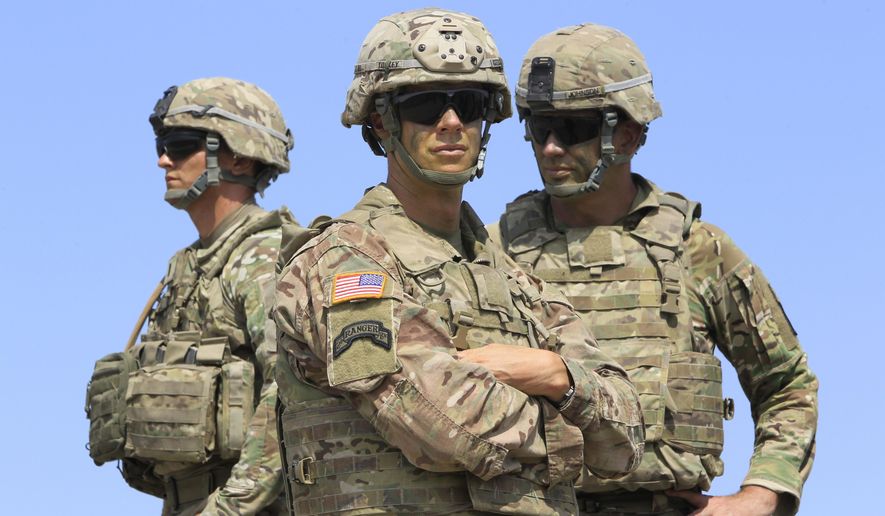The Army will shift about $1 billion to recruiting programs and will rely more heavily on reserve units as its ranks dwindle and the service struggles to attract new soldiers, Army officials said in a memo this week that described a high-stakes “war for talent” that confronts America’s armed forces and comes at a crucial moment for national security.
Faced with demographic shifts and a red-hot civilian job market, Army officials said the number of active-duty soldiers is expected to drop considerably over the next several years.
They said the Army’s strength will be about 466,000 by the end of the fiscal year. It could drop to as low as 445,000 by the end of 2023, they said, “barring a significant positive change in the current recruiting environment.”
The forecast leaves the Army about 10,000 soldiers short of its planned end strength this year. If the trend continues as Pentagon leaders expect, the Army will fall much shorter from its goal next year.
Army leaders acknowledged the scope of the problems and said it will take an all-hands-on-deck approach to turn the tide. With two months left in the fiscal year, the service is just 50% of the way to reaching its annual recruiting target.
“The United States Army exists for one purpose, to protect the nation by fighting and winning our nation’s wars as a member of the Joint Force, and our readiness depends on a quality all-volunteer force. This is not a recruiter problem. This is an Army problem,” Army Secretary Christine Wormuth and Army Chief of Staff Gen. James C. McConville said in the memo released Wednesday evening. “We are in a war for talent, and it will take all our people — soldiers across all components, families, Army civilians, and soldiers for life — to fight and win this war.”
Recruitment officials for the Air Force, Navy and Marines say they are facing similar challenges.
The shortfall in the ranks is growing at a challenging time for the Pentagon. Russia’s Feb. 24 invasion of Ukraine has sparked significant deployments of U.S. troops to Europe, including the establishment of a permanent headquarters for the 5th Army Corps in Poland that President Biden announced this month. It’s the biggest in a set of moves to ramp up U.S. ground forces in Europe, and much of that burden will fall on the Army.
The Pentagon also is racing to expand its presence in the Pacific amid rising tensions with China and fears that a Chinese military move on Taiwan is on the horizon. The Navy, Air Force and Marine Corps will bear much of that responsibility, but the Army, the largest of the military services, also will play a key role.
Service officials acknowledge that the Army’s force structure may need revisions if its ranks keep shrinking.
“We don’t need to do that immediately. But if we don’t arrest the decline that we’re seeing right now in end strength, that could be a possibility in the future,” Gen. Joseph Martin, vice chief of staff of the Army, told a House Armed Services subcommittee this week.
Army leaders blamed a combination of circumstances for the problems, including a shrinking percentage of young Americans fit for service and an inability to recruit in high schools during the COVID-19 pandemic, when many students attended school virtually.
Remote learning, they said, seems to have had a negative impact on the number of young Americans qualified for military service, including “a decline in academic and physical fitness levels.”
Although inflation looms as a major problem for the economy, the U.S. job market continues to post strong numbers. The overall jobless rate is just 3.6%, and youth unemployment — which soared to nearly 30% at the height of the COVID-linked economic shutdown of 2021 — is at a historically low 8.1%. Military services have historically posted stronger recruiting numbers when the alternatives in the private sector are not so attractive.
Deeper problems
The Army says it sees much deeper problems across U.S. society. Officials cited a “knowledge gap” that has prevented the Army from reaching many Americans and an “identity gap” that keeps potential recruits from seeing themselves in the service or understanding its culture.
Perhaps most troubling, military leaders said, is that young Americans appear to become disillusioned with the armed forces, creating a “trust gap” that is difficult to bridge.
“Younger Americans are losing trust and confidence in many American institutions, including the military,” Ms. Wormuth and Gen. McConville said.
Their memo laid out a host of initiatives and programs to attract recruits and keep enlisted soldiers in the ranks. Officials also said they will have to make sweeping changes to the 2023 budget to address looming problems.
Ms. Wormuth and Gen. McConville said they will shift up to $1.2 billion from other Army programs to recruiting initiatives, retention bonuses and other efforts.
Money also will be shifted to Army Reserve units, they said, “to meet operational demands” in light of the service’s manpower shortage.
The Army also will launch future soldier pilot programs, extend the service’s best recruiters, increase funding for enlistment bonuses, offer recruits a greater voice in where they will be stationed, open more regional marketing offices across the country and take other steps to attract recruits.
The latest troubling recruiting data will add fuel to criticism of the Army’s punishment of soldiers who refuse to receive COVID-19 vaccinations. As of July 15, 1,336 active-duty soldiers were removed after refusing the vaccine, officials said.
Another 11,056 Army National Guard service members and 6,733 Army Reserve troops have refused the shot, according to the latest data. None of them has been formally discharged from the ranks.
• Ben Wolfgang can be reached at bwolfgang@washingtontimes.com.




Please read our comment policy before commenting.